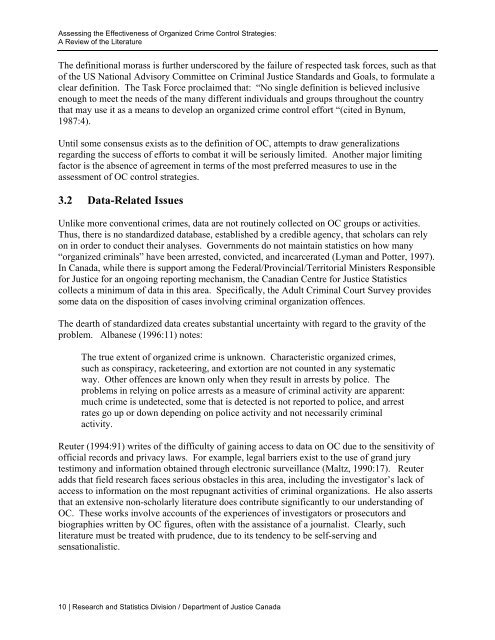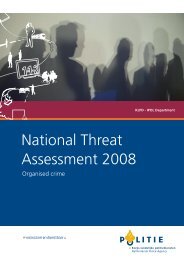Assessing the Effectiveness of Organized Crime Control Strategies ...
Assessing the Effectiveness of Organized Crime Control Strategies ...
Assessing the Effectiveness of Organized Crime Control Strategies ...
Create successful ePaper yourself
Turn your PDF publications into a flip-book with our unique Google optimized e-Paper software.
<strong>Assessing</strong> <strong>the</strong> <strong>Effectiveness</strong> <strong>of</strong> <strong>Organized</strong> <strong>Crime</strong> <strong>Control</strong> <strong>Strategies</strong>:<br />
A Review <strong>of</strong> <strong>the</strong> Literature<br />
The definitional morass is fur<strong>the</strong>r underscored by <strong>the</strong> failure <strong>of</strong> respected task forces, such as that<br />
<strong>of</strong> <strong>the</strong> US National Advisory Committee on Criminal Justice Standards and Goals, to formulate a<br />
clear definition. The Task Force proclaimed that: “No single definition is believed inclusive<br />
enough to meet <strong>the</strong> needs <strong>of</strong> <strong>the</strong> many different individuals and groups throughout <strong>the</strong> country<br />
that may use it as a means to develop an organized crime control effort “(cited in Bynum,<br />
1987:4).<br />
Until some consensus exists as to <strong>the</strong> definition <strong>of</strong> OC, attempts to draw generalizations<br />
regarding <strong>the</strong> success <strong>of</strong> efforts to combat it will be seriously limited. Ano<strong>the</strong>r major limiting<br />
factor is <strong>the</strong> absence <strong>of</strong> agreement in terms <strong>of</strong> <strong>the</strong> most preferred measures to use in <strong>the</strong><br />
assessment <strong>of</strong> OC control strategies.<br />
3.2 Data-Related Issues<br />
Unlike more conventional crimes, data are not routinely collected on OC groups or activities.<br />
Thus, <strong>the</strong>re is no standardized database, established by a credible agency, that scholars can rely<br />
on in order to conduct <strong>the</strong>ir analyses. Governments do not maintain statistics on how many<br />
“organized criminals” have been arrested, convicted, and incarcerated (Lyman and Potter, 1997).<br />
In Canada, while <strong>the</strong>re is support among <strong>the</strong> Federal/Provincial/Territorial Ministers Responsible<br />
for Justice for an ongoing reporting mechanism, <strong>the</strong> Canadian Centre for Justice Statistics<br />
collects a minimum <strong>of</strong> data in this area. Specifically, <strong>the</strong> Adult Criminal Court Survey provides<br />
some data on <strong>the</strong> disposition <strong>of</strong> cases involving criminal organization <strong>of</strong>fences.<br />
The dearth <strong>of</strong> standardized data creates substantial uncertainty with regard to <strong>the</strong> gravity <strong>of</strong> <strong>the</strong><br />
problem. Albanese (1996:11) notes:<br />
The true extent <strong>of</strong> organized crime is unknown. Characteristic organized crimes,<br />
such as conspiracy, racketeering, and extortion are not counted in any systematic<br />
way. O<strong>the</strong>r <strong>of</strong>fences are known only when <strong>the</strong>y result in arrests by police. The<br />
problems in relying on police arrests as a measure <strong>of</strong> criminal activity are apparent:<br />
much crime is undetected, some that is detected is not reported to police, and arrest<br />
rates go up or down depending on police activity and not necessarily criminal<br />
activity.<br />
Reuter (1994:91) writes <strong>of</strong> <strong>the</strong> difficulty <strong>of</strong> gaining access to data on OC due to <strong>the</strong> sensitivity <strong>of</strong><br />
<strong>of</strong>ficial records and privacy laws. For example, legal barriers exist to <strong>the</strong> use <strong>of</strong> grand jury<br />
testimony and information obtained through electronic surveillance (Maltz, 1990:17). Reuter<br />
adds that field research faces serious obstacles in this area, including <strong>the</strong> investigator’s lack <strong>of</strong><br />
access to information on <strong>the</strong> most repugnant activities <strong>of</strong> criminal organizations. He also asserts<br />
that an extensive non-scholarly literature does contribute significantly to our understanding <strong>of</strong><br />
OC. These works involve accounts <strong>of</strong> <strong>the</strong> experiences <strong>of</strong> investigators or prosecutors and<br />
biographies written by OC figures, <strong>of</strong>ten with <strong>the</strong> assistance <strong>of</strong> a journalist. Clearly, such<br />
literature must be treated with prudence, due to its tendency to be self-serving and<br />
sensationalistic.<br />
10 | Research and Statistics Division / Department <strong>of</strong> Justice Canada








